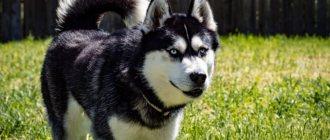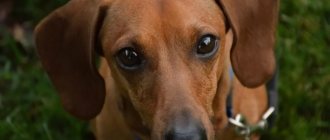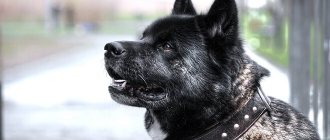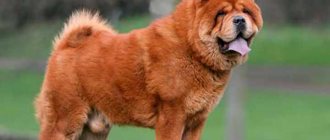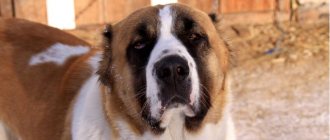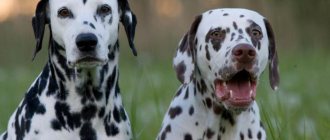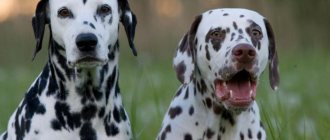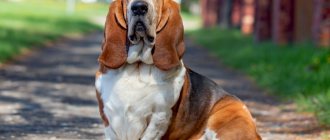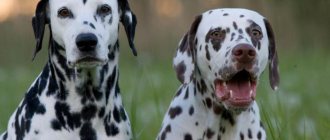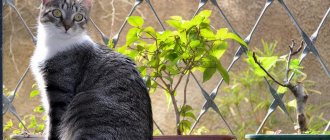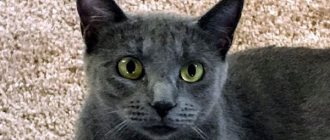Home » Interesting collections about cats and dogs
Dog breeds bred in France are usually called French. This group includes dogs with different character traits, appearances and sizes. They are united only by beauty and a certain nobility in appearance.
- 2 Artois Hound
- 3 Bichon Frize
- 4 Dogue de Bordeaux
- 5 Beauceron
- 6 Briard
- 7 Blue Gascony Basset
- 8 Continental Toy Spaniel
- 9 Small lion dog
- 10 Pyrenees Mountain Dog
- 11 Poodle
- 12 French Bulldog
Anglo-French small hound
A graceful hunting dog in good health. Medium size - from 46 to 58 cm at the withers.
There are three color options for the Anglo-French Lesser Hound: white and red, white and black and tricolor
The Anglo-French hound is obedient, energetic, and loves long walks. She needs space, so it is not advisable to keep her in a city apartment.
Breton epagnol (Brittany)
Breton epagnol (Brittany)
The Breton Epagnole is another French hunting breed. They were bred in the 17th-18th centuries for hunting birds. Currently, in terms of numbers, it is the first and most widespread breed of pointing dog in France. This dog is probably the oldest representative of the spaniel-type cops, which at the beginning of the 20th century were refined through various crossings and selection.
Artois hound
A medium-sized hunting dog, 52–59 cm high at the withers, hardy and in good health.
At one time, the breed almost disappeared, since purebred Artois hounds were too actively crossed with English dogs
The friendly Artois hound will not become a watchman or security guard, but will be an excellent companion for walks and in active games.
Picardy Shepherd
The Picardy Shepherd was named after the region of Picardy in northern France, where the breed has existed for hundreds of years. These herding dogs were prized for their stamina, independent thinking, and drive. They have strong ties to two other French shepherds, Briard and Beauceron.
Their numbers were decimated when the fields they worked in were ravaged during World War II, and to this day they remain a relatively rare breed.
If you are looking for a loyal, intelligent and adventurous dog that will successfully accompany you on daily hikes and in dog sports, the Picardy Shepherd may be the dog for you.
They may have independent traits and may be wary of strangers, so a lot of appropriate, early and ongoing socialization will be required to prevent them from becoming overly nervous or reactive.
Bichon Frize
A small decorative dog, from 15 to 30 cm in height. It is in good health and can live up to 18 years.
Among the Bichon Frize there are long-livers, living up to 18 years.
The Bichon Frize is a companion and needs companionship. Wool requires careful care, but is hypoallergenic.
I’m talking specifically about my Bichon... he’s only good for the house, or you can go for a walk with him. Going to the forest, going on a hike, walking around the city - no longer needed - you quickly get tired and then you begin to ride on your hands. Ours is already 14 years old, he lived all the time in a private house - an excellent security guard - no lack of courage.
Petrycho
https://irecommend.ru/content/khoroshaya-tsabaka-no-tolko-dlya-doma
Continuation of the post “Help, advice needed”
Thanks to everyone who responded, gave good advice, empathized, and sympathized. Special thanks to TanyaTheSlayer, who with her comment brought us down to earth and spurred us to action. In our village, we completely forgot that #covid# is spreading across the country. And in fact, frightened by the prospects that were in the spring, when regions were blocked for entry, we decided to act quickly. We inform everyone who is interested that a decision has been made and we are moving forward on 10/16/20. (Postponing urgent matters for later)
This is our French bulldog, home call sign - Nafanya, Fanya, Fantik. The eighth year has begun. He goes with us for Kuzya.
Beauceron
The Beauceron breed is rare. The dog is large, 61–70 cm at the withers. Health is normal, but problems with bones, eyes and intestines may occur.
The first information about the breed was found in a manuscript dating back to 1578, but it was not until 1863 that it was officially recognized
The Beauceron is a good protector, but requires training.
How to choose a Frenchie puppy?
Before buying, the future owner should know everything about the puppies: in what conditions they grew up, what they ate, whether they were vaccinated, who their parents are, etc. It is recommended to buy a little Frenchie when he is at least eight weeks old. Optimally - from ten to twelve weeks.
You should only look for a French bulldog puppy in official shelters and kennels. They will issue the baby's card, his pedigree and a vaccination diary.
What to look for when choosing a baby:
- Size. The puppy should not be emaciated or, conversely, obese.
- Activity. A healthy four-legged animal behaves playfully. The male is usually more active than the female. Boys also have more strength.
- Contact. If the puppy is shy, hides in a corner and is afraid of people, it means that he is not socialized or is intimidated.
- Appearance. Examine the fur, ears, eyes and teeth. Everything must be clean.
A few tips will help novice owners choose the gender of their dog:
- If you want to buy an easy-going and calm pet, you need to buy a female French bulldog. In addition, the girl is much smarter and easier to train. However, remember that estrus occurs twice a year. During this period, the female needs careful monitoring and enhanced care.
- If you want an energetic, active and restless pet, you need to take a male. We must not forget about raising the dog, otherwise the French male will be aggressive towards other animals.
Briard
A large breed, 56–68 cm high. Briards can be guide dogs. Very loyal, but jealous, need training and early socialization.
Briards were originally herding dogs; a sedentary lifestyle is not suitable for them and they definitely need physical activity.
Playful and easy to train. Health is average, there is a tendency to a number of diseases.
For those who consider long hair to be a disadvantage of the Briard, I will say that their hair is of the goat type. It practically does not tangle, so brushing the dog once or twice a week is enough. And in the summer you can cut it, by winter it will have grown enough. It is also important that wool has no smell; many different knitted products are made from it.
alenka100500
https://irecommend.ru/content/khoroshii-vernyi-drug-otlichnaya-nyanya-s-foto-vzrosloi-i-shchenka
Dogue de Bordeaux
- Height: from 58 to 68 cm
- Weight: from 45 to 50 kg
- Life expectancy: 8 to 12 years
- Average cost: from 1800 to 2500 dollars
Another ancient French dog breed , the slobbering Dogue de Bordeaux is a gentle giant whose biography could just as easily be an epic novel. According to some reports, even in ancient times, the Romans were interested in having the ancestors of the Dogue de Bordeaux accompany their legions, and even brought representatives of this mastiff breed to France. Many centuries later, the Dogue de Bordeaux began to be used by the French nobility as a hunting partner and guard dog for estates. And these days they are wonderful companions for the home.
WARNING! The Dogue de Bordeaux has natural guarding instincts that can make him less friendly or even aggressive, especially around people he doesn't know.
The Dogue de Bordeaux was originally bred as a guard dog , so it is fiercely protective of its family. On the other hand, the breed can be very friendly and good-natured if raised and trained correctly.
Continental Toy Spaniel
This breed is also called Papillon, although this name is not entirely correct. The Papillon is a continental toy spaniel with erect ears. There is also a hanging variety called phalen.
Continental Toy Spaniels take 8th place in intelligence in the general breed ranking of dogs and 2nd place among decorative breeds
Toy spaniels are small in size, only 20–28 cm at the withers. This is a decorative breed, but at the same time it is easy to train.
Two-color toy spaniels are most valued by breeders.
Wool requires care, but is considered hypoallergenic. The dogs are fairly healthy, although there may be problems with bones and vision.
We had a child when the toy spaniel was one year old, Charlie was not jealous, but on the contrary, he fell in love with our daughter and also loves to play with her, bringing her his toys))) He protected the stroller from strangers who tried to approach. In general, the child has a lot of fun with such a dog! It's so cute when they play)))
zhu4okpa4oK
https://irecommend.ru/content/nastoyashchii-kompanon-i-samaya-umnaya-sobaka-sredi-malenkikh
Papillon
- Height: from 20 to 28 cm
- Weight: from 3 to 5 kg
- Life expectancy: 13 to 17 years
- Average cost: from 1000 to 2000 dollars
The rambunctious Papillon may be small in size, but get to know him a little closer and you'll discover a personality twice his size hiding behind his cute exterior. So if you're planning on spending the evening on the couch with your Papillon curled up on your lap, you may need to reconsider your plans. This breed loves nothing more than to explore every nook and cranny of the house, chase rodents, and give profuse kisses to anyone who walks through the door - friend or stranger.
Although these days Papillons are often seen tucked under their owner's arms or striding down the street on their miniature paws, this breed of dog was once the best friend of royalty and has graced many noble homes over the centuries, with quite a few Renaissance paintings to prove it. .
Small lion dog
The Lion Dog or Löwchen is a small decorative breed, 25–33 cm high. An excellent companion that needs people's attention and active walks.
The standard describes the Lövchen as a smart little dog with a lively and attentive look, affectionate and obedient
Health is good, but there may be problems with the eyes and knees.
Description and characteristics of the breed
Frenchies are an independent breed, and not a subspecies of the English bulldog (as is sometimes mistakenly thought). Further in the article, the body structure and character traits of the French are described.
Dimensions (weight, height)
The height at the withers and body weight of a French bulldog depend on the gender of the pet. Thus, the height of males is from 27 to 35 centimeters, and the height of females is from 24 to 32 centimeters.
The normal weight of large purebred male dogs can be 9-14 kilograms, and the weight of an adult female bulldog dog can be 8-13.
Head and neck
The Frenchie's head is square and quite wide. Due to this structure of the skull, representatives of the breed have progeny - a bite in which the incisors of the lower jaw protrude in front of the incisors on the upper jaw. This bulldog bite is found in many short-faced breeds.
Sometimes Frenchie puppies are born with a cleft palate. The pathology requires surgical treatment.
The French Bulldog's neck is short and quite dense, covered with skin folds.
Nose, ears, eyes
The bulldog has large ears, rounded at the tips. The French dog's ears are erect.
The animal's eyes are quite large, round, and the iris is dark in color.
The nose is flat and slightly turned up. Nose color is black or dark brown.
Language
If the dog is in a relaxed state, the tongue is not normally visible. While walking or running, the Frenchman often pulls his tongue out. Normally, the tongue is moist and pinkish in color.
Muzzle
The French Bulldog has a short muzzle; there are characteristic folds on the forehead, located symmetrically. The nose is flattened, which is why the French dog often breathes heavily, making grunting sounds.
Torso
The Frenchman has a rather powerful physique: a square, strong body, a muscular back and strong limbs. At the same time, the French dog is quite stocky.
Front and hind limbs
The Frenchie's front legs are slightly shorter than the back legs. This creates a slouching effect when the dog is standing.
Tail
French bulldog puppies are born with short tails that remain that way for life. The only difference is its different curvatures: for example, there is a “knot” tail or a “corkscrew” tail. It can also be straight, without kinks.
Wool
The French Bulldog's coat is short and there is no undercoat underneath. The structure of the fur is hard and dense, so the pet will not shed or get dirty. As for the coat colors of Frenchies, the main ones are:
- With stains. Usually, with this color, tiger spots are randomly located on the white fur coat.
- Pale yellow. This color implies a smooth transition of color from rich red to the color of coffee with milk.
- Brindle. There are both red stripes on a black coat, and vice versa.
- Black. Pure black color, not diluted with stripes or spots, is not approved by the breed standard.
Character and temperament
The striking character traits of the French Bulldog are:
- Tenderness. The Frenchie is a very affectionate and pleasant friend who loves to be in the center of events. However, the dog treats his owner jealously.
- Gullibility. The Frenchman is not shy about strangers. He will study guests with ease and great interest, expecting attention from them. But if the owner is nearby, the dog will give preference to him.
- Lack of hunting instincts. Sometimes male Frenchies show aggression towards foreign animals, but this is most likely due to his bad manners.
- Playfulness. The Frenchie is often left to play with children, because you definitely won’t get bored with this four-legged dog.
- Fast adaptation. The Frenchie adapts to the rhythm of his owner’s life. That’s why older people who lead a quiet lifestyle start it. The pet will always be nearby and behave calmly.
Pyrenean mountain dog
Large dogs, 65–80 cm tall at the withers. Strong, in excellent health. Beautiful white wool also has disadvantages - the animals shed heavily.
Pyrenean Mountain Dogs are good watchdogs
Pyrenean mountain dogs are loyal and independent animals that require training. They need space, so it is better not to keep the breed in a city apartment.
Louchen
An amazing breed with an unusual appearance: the upper part of the Lowchen’s body is covered with thick hair, reminiscent of a lion’s mane. But the lower part is practically bare.
Russians can be rewarded financially if they restore forests
The head of Rospotrebnadzor told where it is better to spend the May holidays
You can make convenient flower stands from inexpensive photo frames: an easy way
The breed is one of the most expensive. The first lowens were reflected in the art of the Renaissance: thanks to the paintings of the masters, we know that the external data did not change for five centuries. The dogs are very cheerful and restless, but will successfully become family companions.
Poodle
Now the poodle is considered a decorative dog. This is a recognized companion, although the breed was originally used as both a hunting and a herding dog. Poodle varieties differ in height:
- large - 43-62 cm;
- small - 35-45 cm;
- dwarf - 28-35 cm;
- that one - 23-28.
The Poodle ranks second on Dr. Stanley Coren's list of the smartest breeds.
All poodles are intelligent and easy to train. Careful grooming is required. Health is not very good; there are a number of diseases to which the breed is genetically predisposed.
Basset Hound
- Height: from 33 to 38 cm
- Weight: from 18 to 27 kg
- Life expectancy: 10 to 12 years
- Average cost: from 800 to 1500 dollars
Many people think that the Basset Hound comes from England, but in fact the breed originated in France, where it was used to hunt rabbits, hares and wild boars, and the name "basset" translates to "short" or "low", and "hound" " - "hound".
Their creation is somewhat accidental, as Basset Hounds are the result of short-legged mutations that sometimes occur in traditional bloodhound breeds. Instead of abandoning these dogs, they began to take them for hunting in places where a horse could not go. The Basset Hound came to England in 1866, where it was crossed with the Bloodhound to create a bloodhound with a more dense build than the original French dog - and this is the Basset Hound we know today.
Fun fact: Basset Hounds are the second best bloodhounds in the dog world, second only to the Bloodhound. Their long, floppy ears carry scents from the ground directly to their noses, which helps them find tracks better.
Basset Hounds are now popular as family dogs due to their calm and affectionate nature. Despite its gloomy and serious appearance, this breed is sociable, meek and quite quiet, although sometimes quite playful. Basset Hounds are affectionate with family and reserved with strangers, they love children and get along well with other dogs and pets. These are very sociable dogs that hate being left alone, and therefore always need company - be it a person or a dog.
Reviews
Yulia, 44 years old I have loved Airedale terriers since childhood. I became an adult and bought my first puppy, Charlie. The character turned out to be complex. He had a lot of conflicts, ran away, and didn’t listen. I had to turn to dog handlers; I couldn’t have done it alone. Following Charlik, I acquired another one. Terry has been there for 5 years and has had no problems. I would call him a little lazy. Dogs are very different. It is difficult to say that this is a hunting breed. More like a service one. My real assistants in protecting the dacha and home.
Peter, 28 years old My Asterlix is a West Highland White Terrier. Everyone affectionately calls them “Vestiki”. A wonderful dog who is ready to walk in the park for hours. The only drawback is that it constantly “sniffs” and picks up everything from the ground. As soon as I didn’t wean myself off it. Does not work. He goes with me everywhere, loves the car, and is crazy about trips to the river. You have to wash it constantly, because white wool and the city do not mix well. Otherwise, a wonderful friend who will happily sit with you in front of the TV, watch a sports match, and will simply always be there. I love it.
Alexandra Petrovna, 62 years old The doctor advised me to constantly walk after the operation. She would never leave the house on her own, but with a dog it’s a different matter. For their 60th birthday, the children gave them a tiny Yorkshire terrier puppy. I immediately fell in love. Marta is a sincere, devoted dog. We are with her everywhere. It's nice to pamper her, buy her treats, dress her in different ways. She is a calm, balanced lady, but as soon as she sees a big dog, she gets wildly hysterical. It is clear that this is out of fear. It looks funny, there were many comical situations. If it weren’t for Martochka, I would still be lying on the sofa, watching TV. Now I have a schedule, we walk around our area as a group. New friends have appeared who are passionate about dog breeding.
Love, 45 years old One day my husband brought a puppy. I was categorically against having a dog in the house, and besides, one of the children has a severe allergy to wool. It turned out to be a Kerry Blue Terrier. According to the assurances of the spouse, the child will not have problems. The puppy was growing, and I kept my medications at the ready, I was still afraid that an asthma attack would begin. Myron is already 5 years old. All this time I did not believe that there would be no problems. The husband and children are taking care of the dog. The new doctor who appeared at our site confirmed that my fears were in vain. I didn't even know there were hypoallergenic dogs. Everyone loves the dog for his cheerful disposition.
Semyon, 38 years old I saw burrow hunting on TV and was inspired to take up it. I really liked the idea that you could catch an animal without shooting. Friends advised me to adopt a burrow terrier. I spent a long time choosing between a dachshund and a smooth fox terrier. And then a friend of mine has a new litter. He took a friend and named him Hunter, which means hunter. You have no idea how smart and loyal this dog is! He and I not only mastered the commands, but also regularly participate in competitions and go to exhibitions. For me this is a real outlet. My dream of catching an animal without a weapon came true. Hunter is a tenacious dog with a strong character, he is just a copy of me.
Body type
The back is strong and short, wider at the shoulders and tapering towards the back of the head. The body is short and rounded. The chest is wide, deep and full, ribbed, with a tucked belly. The tail is straight or curled (but not curly), short, hanging low, thick at the root and thin at the tip.
The front legs are short, thick, straight, muscular, and widely spaced. Thumbs may be removed. The hind feet are moderate in size (slightly longer than the front feet), compact and firmly set. The toes are small, well split, with high joints and short nails.
First club
Bulldogs were very popular in the past, especially in Western Europe. Americans had been importing French Terriers for some time, but it was not until 1885 that they were brought in to create the American breeding program. The dogs were mostly owned by society ladies, who first showed them at the Westminster Kennel Club dog show in 1896. The French Bulldog Club of America was formed and a French Terrier standard was created stating that "bat ear" was the correct type.
What types of terriers are there?
The largest group of terrier breeds was developed in England, with several varieties being of Asian origin. There are also single subspecies, for example, the American Staffordshire Terrier.
In general, terriers are divided into four main groups:
- Large and medium;
- Small;
- Representatives of the "boule" type;
- Toy terriers.
The most numerous is the first group. The lineage of its representatives stretches back to the beginning of the 18th century. And the most common is the last one; every third family in Europe has its decorative representatives.
Health problems
The main health problems in French Terriers are:
- Hip dysplasia. This is an inherited condition in which the femur bone does not fit tightly into the pelvic socket of the hip joint. Some dogs experience pain and lameness in one or both hind legs. Arthritis can develop with age.
- Brachycephalic syndrome. This disorder occurs in dogs with small heads, narrowed nostrils, and elongated or soft palates. Their airways are obstructed and can cause noisy, labored breathing or complete collapse. Dogs usually sniffle and snort. Treatment includes oxygen therapy and surgery to widen the nostrils or shorten the palate.
- Allergy. There are three main types: food, contact and inhaler allergies. They are caused by certain foods in a dog's diet, flea products, dog shampoos, household chemicals, pollen, dust and mold.
- Hemivertebrae. This is a malformation of one or more vertebrae. The anomaly can occur on its own or with other defects.
- Pathology of the knee joints. This is a common problem in small dogs. It is caused when the kneecap, which is made up of three parts (the femur, patella and tibia), is not properly aligned and slips in place. This causes lameness or abnormal gait. The disease is congenital. It can lead to arthritis. Severe degrees of patellar luxation may require surgical intervention.
- Intervertebral disc disease. Occurs when a disc in the spine ruptures. It puts pressure on the spinal cord. Nerve transmission is blocked. It can be caused by injury, age, or simply the physical jolt that occurs when a dog jumps off the couch. The pet usually feels pain. Weakness and temporary or permanent paralysis occur. Treatment includes non-steroidal anti-inflammatory drugs made specifically for dogs.
Nutritional Features
French bulldogs require careful selection of their diet, as they are prone to gastrointestinal problems, food allergies and obesity. It is recommended to alternate between ready-made dry food (premium grade only) and natural food. Buy a bowl for your pet with a vertical stand, adjustable in height, provide access at the level of the dog’s chest. This will make drinking and eating more convenient. Change the water every day and remove any leftover food immediately.
Want to eat
Recommended natural products:
- raw lean meat, cut into pieces;
- boiled sea fish without bones;
- porridge;
- seasonal vegetables and fruits (primarily green);
- chicken eggs;
- fermented milk products (cause diarrhea in some dogs).
Completely exclude fatty meat, river fish, smoked meats, sweets, baked goods, and gas-forming products (beans, cabbage) from your dog’s diet. Puppies up to 2 months are fed 6 times a day, at 3 months - 5 times a day, at 4-7 months - 4 times, at 8-12 months - 3 times. You can switch to two meals a day per year. Monitor portion sizes as French Bulldogs tend to overeat. Do not give very hot or cold food/drink.
